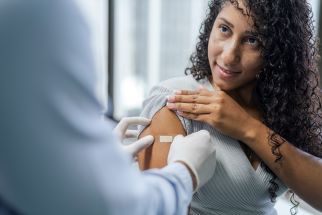April 2024
Act to Prevent Cervical Cancer
Every year, providers diagnose about 13,000 new cases of cervical cancer. And it’s estimated that the disease claims approximately 4,000 lives annually. Yet when it’s caught early enough, cervical cancer is highly treatable.
Learning how this deadly cancer can be prevented, diagnosed, and treated can help you protect yourself.

Q: What causes cervical cancer?
A: Long-lasting infection of HPV (human papillomavirus) is the main cause of cervical cancer. It is the most common sexually transmitted infection (STI). The CDC estimates that almost everyone will get at least one type of HPV within a few years of becoming sexually active. But only a few of the more than 200 kinds of HPV actually cause cancer. In most instances, the infections disappear on their own within 2 years.
Q: What raises my risk for cervical cancer?
A: Aside from HPV infection, the following risk factors increase your odds of developing cervical cancer:
-
Smoking
-
Having given birth to 3 or more children
-
Using birth control pills for a long time
-
Having HIV or another condition that makes it hard for your body to fight off health problems
Q: What are the symptoms of cervical cancer?
A: Women with early cervical cancers and precancers usually don’t have symptoms. But once the cancer becomes larger and grows into nearby tissue, women may experience abnormal vaginal bleeding, unusual discharge from the vagina, and pain during sex.
Q: How is cervical cancer detected and treated?
A: Screenings can help find a health problem before a person has symptoms. Two screening tests are available for cervical cancer: Pap tests and HPV tests. With a Pap test, your healthcare provider can collect cells from your cervix. They check these cells in a lab for abnormal changes that may be cervical cancer or lead to cervical cancer. HPV tests check if you’re infected with a high-risk type of HPV that may lead to cancer. Pap and HPV tests may be done alone or at the same time. Abnormal results from either screening may mean you need more testing, such as a biopsy to check for precancer or cancer.
Caught early, in its precancerous stage, the disease can often be treated successfully before the cells become cancerous.
Several factors help determine how best to treat cervical cancer, including the kind of cervical cancer and how far it has spread. Treatments may include surgery, chemotherapy, immunotherapy, targeted therapy, and radiation therapy.
Q: What can I do to prevent cervical cancer?
A: Take these steps to lower your risk of developing cervical cancer:
-
Get an HPV vaccine. All kids should get 2 doses of the HPV vaccine at age 11 or 12. Those who start the vaccination series later—at ages 15 through 26—will need a third shot. The vaccine is estimated to prevent 90% of HPV-related cancers.
-
Receive cervical cancer screenings. The CDC recommends women start Pap tests at age 21. If results are normal, women ages 21 to 29 can get a Pap test once every 3 years. Women ages 30 to 65 years can choose to have a Pap test, HPV test, or both. If results are normal, they will have a Pap test every 3 years, an HPV test once every 5 years, or a Pap test and an HPV test once every 5 years. Women older than 65 who have had normal results for several years and do not have a history of cervical precancer can stop screenings. Talk with your provider about the schedule that is best for you.
-
Practice safe sex. Using condoms correctly doesn’t fully prevent HPV transmission, but it can lower your chance of getting the virus.
Remember: Cancer of the cervix can be deadly. However, you can take steps to prevent or detect it.